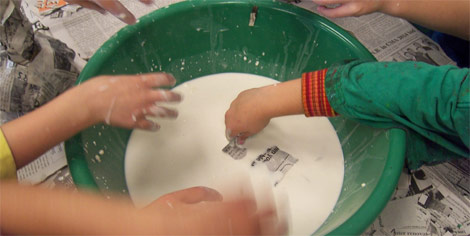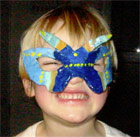There’s one craft you can have a huge amount of fun with, costs next to nothing, and can be used to make decorative or useful items. It's Papier Mâché!
 Did those two words strike fear into your heart? For many of us Papier Mâché (or paper mache) is something we only slightly remember from our childhood, in a vaguely terrifying kind of way. You might recall lots of gluey, gunky stuff and globs of pulpy paper, that dried to a hardened mass on something irreplaceable like the French polish finished surface of the dining room sideboard.
Did those two words strike fear into your heart? For many of us Papier Mâché (or paper mache) is something we only slightly remember from our childhood, in a vaguely terrifying kind of way. You might recall lots of gluey, gunky stuff and globs of pulpy paper, that dried to a hardened mass on something irreplaceable like the French polish finished surface of the dining room sideboard.
And all we’d end up with is some sort of lopsided bowl, which wasn’t really a lot of fun, and eventually went a bit mouldy.
It is time to give Papier Mâché a second chance. This is an especially fun craft to do in the warmer months when you can spread it all out on plastic sheets, and hose the kids down afterwards. We’ve picked the brains of artists, writers, readers of this blog, and scoured the internet, to bring you all the Papier Mâché top tips we could find in one handy place. Read on to find out all you need to know about the best glues, paper, and crafty advice for what to do with all that pulpy stuff.
Globs of gunky, gluey, goodness

What ingredients make a really good glue for your Papier Mâché creations? It seems that you’ve got three main options.
Option One: Cheap, mucky but definitely cheerful - make your own papier mache recipe using flour and water. This is lots of fun for the kiddies and a good option for saving pennies, when you can get packets of plain flour at rock bottom prices. Asda, for example, sell a 1.5kg packet of their own-brand Smart Price plain flour for only 43p. One tip we came across from a number of experienced Papier Mâché users is to add a few spoonfuls of salt to the mix, to act as a preservative and keep it mildew free.
One glue recipe was particularly recommended, and is from a site that popped up again and again whenever we mentioned this craft to anyone: The Papier Mache Resource. It uses one cup of plain, unbleached flour, one teaspoon of salt, and two cups of lukewarm water. Blend salt and flour, then gradually add water while stirring to make a paste. Add enough water so you have a thin, soup-like consistency.
Option Two: Wallpaper paste. Less hassle than making it up yourself with flour; but a little bit less suitable for use with children, depending on their age.
Option Three: PVA Glue mixed with two parts water. More expensive than the other two paper mache recipes, it is also more long lasting. Best suited to projects with older children. It is particularly good for sculptures.
Those are the most popular but once you’re more experienced at working with the pulpy stuff you might want to experiment. Try out some of the more unusual glue ideas and recipes at DLTK’s Growing Together website.
Pots of Paper Possibilities
Don’t listen to negative naysayers who will try to tell you that newsprint is never going to work if you want to paint your creation. Yes, the print will bleed through a layer of poster paint, or even acrylic. But only if you make it your top layer, or don’t use a primer coat, or try to get away with just one layer of colour.
Sheona Gillespie wowed the friends of her daughters at birthday parties for many years with home-made piñatas, and Papier Mâché costume masks. She shared her Papier Mâché secrets with us. “I collect the Financial Times, or some towns have a green sports results paper, and alternated the layers with regular newspaper. That gives you a good idea of where you are with your layers. Make sure your hands are thoroughly wet with glue to smooth the paper nice and smooth.”
“For a Papier Mâché creation that you want to paint, make the final layer out of something like kitchen paper or toilet paper (separate the layers). Or if you know it has to be dark, or a single colour, you can use coloured paper or serviettes.”

Crafty advice
How you mix the glue and paper together depends entirely on what you want to do with the end result. Celine Kiernan, artist and author of the Moorehawke Trilogy recommends using thick wallpaper paste for models, with “very pastey paper, and very very thin layers that should be dried thoroughly before you add the next ones. Or, run the paste and paper together through a foodmixer until smooth and puttylike then use to make thin layers over or inside a support/mould. This can give just the most amazingly lovely result and can be sanded for an excellent finish.”
Sheona agrees, and further suggests using chicken wire for the support/mould, or even just rolled up newspaper, loo roll or kitchen-roll inners, stuck together in the approximate shape. “It gives it a bit more stability and doesn't require so much of the mush.”
 Younger children can make a fabulous mask using just flour paste and thick strips of paper though. There are a lot of suggestions for how to do this on the internet, but the best one we found was, again, at the Papier Mâché Resource, in their tutorials: Make a Papier Mâché Mask. (Thanks Tracy)
Younger children can make a fabulous mask using just flour paste and thick strips of paper though. There are a lot of suggestions for how to do this on the internet, but the best one we found was, again, at the Papier Mâché Resource, in their tutorials: Make a Papier Mâché Mask. (Thanks Tracy)
You really can’t go wrong with a piñata to add a bit of energetic fun to a children’s party. We used this to distribute the party bags, and it made an excellent ending for a 5th birthday party. To make the piñata, we partly used this guide from eHow.co.uk – how to make a piñata. And we mixed in a few tips provided by Sheona. “Piñatas can be made easily and well; you can use big strips and flour/water paste and you only need a few layers because it's not for keeps.” We found that serviettes made a quick finishing layer for a piñata, if you were careful to keep the cut, frilly parts out of the glue!

















Comments